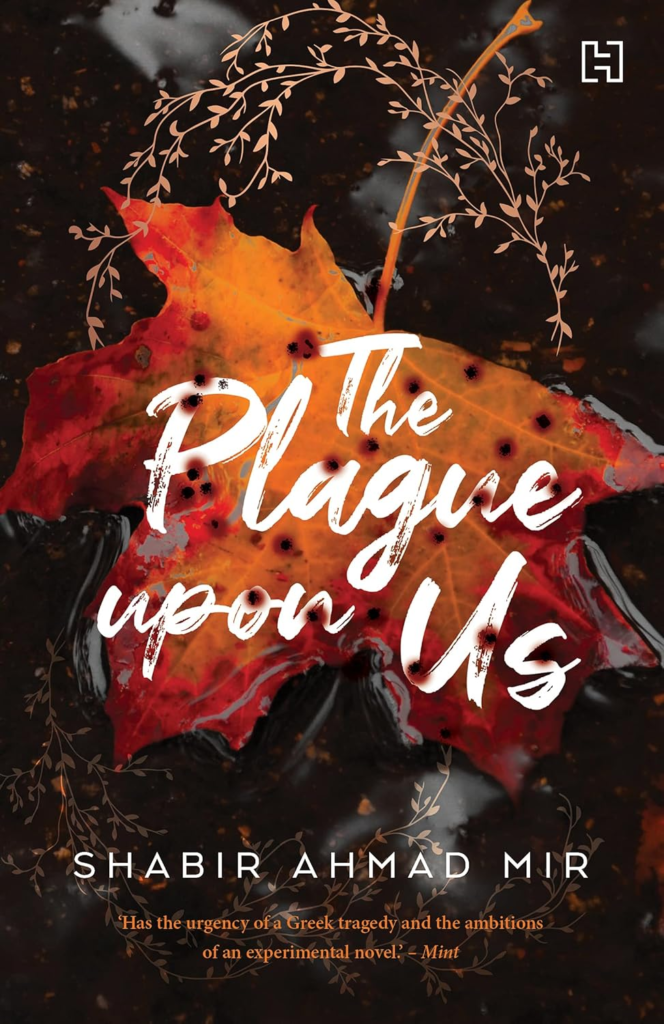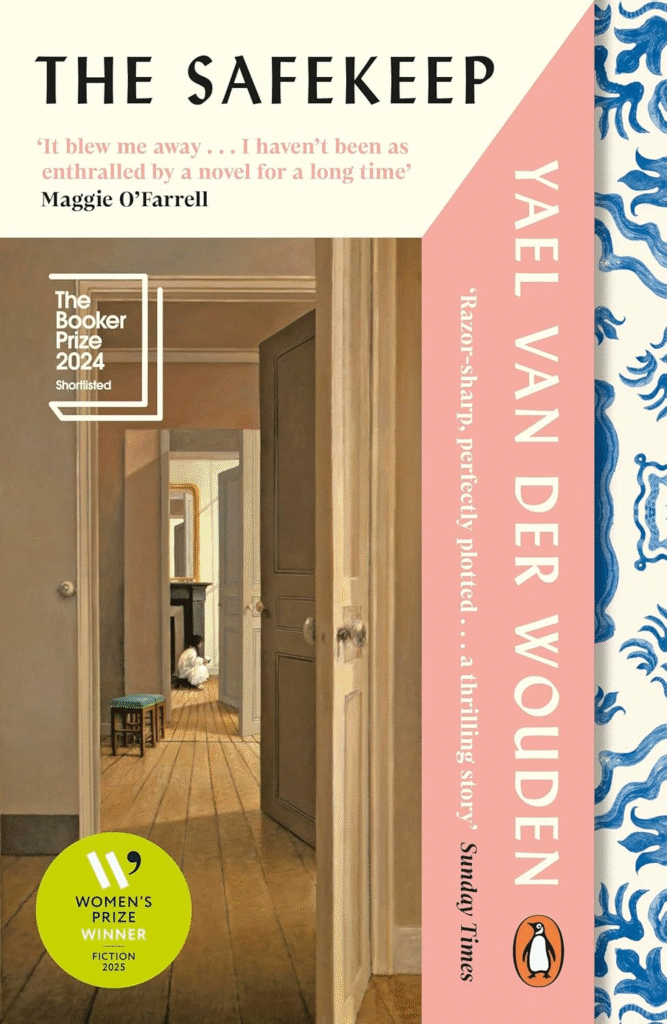
The Plague upon Us by Shabir Ahmad Mir, published on 30 June 2021, is a deeply moving novel set in 1990s Kashmir, a time of intense conflict, pain, and uncertainty and a situation that sadly still echoes in the present. This powerful debut explores the emotional and psychological scars left on a generation of Kashmiris, using fiction to tell the real story of a region torn apart by violence. The novel follows Oubaid, a young man haunted by the memories of bloodshed and the loss of innocence in his homeland. As Oubaid struggles to face his past, the story unfolds through four characters of childhood friends who represent different sides of Kashmiri society: a militant, a rich landlord, the daughter of a social climber, and a Brotherhood member. Their stories, shaped by personal pain and shared history, slowly come together to reveal a painful truth.
What makes The Plague upon Us different from other books on Kashmir is not just the subject, but the way it is written. With poetic language, fictional settings, and a unique narrative style, the author brings out the emotional complexity of life in Kashmir. The book blends memory, fiction, and social commentary, offering readers a fresh perspective on the Kashmir conflict. It is not just a novel, but a voice for a people trying to make sense of their shattered world. Shabir Ahmad Mir’s writing is raw, honest, and interesting and making The Plague upon Us a must-read for anyone interested in understanding the human cost of conflict in Kashmir.
Read Also: Temptations of the West by Pankaj Mishra Review
Availability, Pricing, Details of Book
The Plague Upon Us by Shabir Ahmad Mir is a powerful debut novel published by Hachette India on 30 June 2021. The book is written in English and has 240 pages in its paperback edition. It tells a haunting story of conflict, memory, and loss in 1990s Kashmir through the voices of four interconnected characters. The paperback is priced at ₹393, and the Kindle edition is available for ₹253 on platforms like Amazon India, Goodreads, Flipkart and Hachette India. You should buy the Kindle edition for its lower price, instant delivery, and convenience of reading anywhere.
Read Also: The World After Gaza by Pankaj Mishra – Book Review
About the Author: Shabir Ahmad Mir
Shabir Ahmad Mir is a Kashmiri writer and poet from Gudoora village in Pulwama district. His debut novel, The Plague Upon Us, published by Hachette India in 2020, was shortlisted for the JCB Prize for Literature 2021. Mir has also been recognized for his short stories, notably “The Djinn Who Fell from The Walnut Tree,” which was the first runner-up in the FON South Asia Short Story Contest in 2016. In 2017, he received the Reuel International Prize for Fiction. Beyond fiction, Mir has contributed to academic works in the field of food science and technology. He holds a master’s degree in veterinary sciences and serves as faculty at SKUAST-Kashmir.
Read Also: The Undying Light: India’s Story by G.K. Gandhi
Exploring the Central Themes of The Plague Upon Us
- Trauma and Memory: The Plague Upon Us is deeply rooted in the trauma of the Kashmiri people. Through the protagonist Oubaid, the novel shows how violence becomes part of everyday life. Oubaid hears a voice in his head and a symbol of his broken mind and suppressed memories. He is scared to face the past because it is too painful. But the truth keeps pulling him back. This shows how hard it is to live with trauma that never really leaves. The trauma in The Plague Upon Us is personal, but also collective, shared by an entire society caught in endless conflict.
- Truth and Uncertainty: In The Plague Upon Us, truth is not clear-cut. Everyone has their own version of events. Four different characters tell their stories, each adding a piece to the puzzle. The same events look different from each viewpoint. This makes the reader question: what is the real truth? The book shows that truth is often hidden, twisted, or incomplete especially in a place like Kashmir where politics, war, and survival mix. The Plague Upon Us teaches us that sometimes the truth can hurt more than lies.
- Multiple Voices: The unique structure of The Plague Upon Us lets us hear from four people, all linked by past friendship and shared history. Each voice tells a story that overlaps with the others. As the layers build, we start to see the full picture of what happened. This method mirrors real life in Kashmir where not one story is enough. The Plague Upon Us uses this technique to give a fuller, more human view of the conflict.
- Violence and Beauty: Kashmir is known for its stunning beauty, but in The Plague Upon Us, this beauty stands in painful contrast to the horror of war. Apple orchards, snow-covered peaks, and peaceful valleys are turned into places of fear. Shabir Ahmad Mir shows how the beauty of the land is stained with blood. The novel forces us to ask: how can a place so lovely hold so much pain? The Plague Upon Us makes this contradiction impossible to ignore.
- Identity and Loss: Oubaid, like many characters in The Plague Upon Us, is lost. Not just in terms of where he belongs, but in who he is. The war has stolen not only homes and lives but also identities. Children grow up not knowing who to trust or who they will become. The idea of “belonging” is blurry when every side of the fight uses people for their own gain. Through this the book shows how identity gets broken and rebuilt in places under siege.
- Silence and Voice: A major theme in The Plague Upon Us is who gets to speak and who does not. Many Kashmiri voices are silenced by fear, control, or trauma. Oubaid speaks, but through a haunting, inner voice he cannot shut off. The novel itself becomes a form of resistance in a way to give voice to those often ignored. By telling this story, the book becomes a space where buried truths can be heard.
- Politics and Power: The Plague Upon Us boldly explores how different forces use Kashmir for their own power. Politicians, the military, the Brotherhood, and even businessmen all play roles in keeping the conflict alive. No single side is painted as purely good or evil. Everyone is part of a larger system that uses people like chess pieces. The book does not offer easy answers, but it does ask hard questions. The power is shown as something that often destroys more than it protects.
- Hope and Despair: Though filled with darkness, The Plague Upon Us also shows small moments of hope, friendship, love, and memory. But these are short-lived. The novel ends without closure, much like the real situation in Kashmir. The characters are left with questions, not answers. This lack of a “happy ending” makes The Plague Upon Us more honest, showing how life in conflict zones rarely wraps up neatly.
- War and Innocence: Children in The Plague Upon Us grow up around bloodshed. They do not get to enjoy normal childhoods. Boys throw stones; men carry guns. The line between victim and fighter blurs. Through this, the book shows how war steals innocence and turns the young into weapons or into the wounded. In this novel even laughter feels fragile, like it might disappear any second.
- Reality vs. Fiction: Though the novel uses fictional characters and places, many events mirror real ones like secret torture centres (TALK 1, a nod to PAPA 1). This blending of fact and fiction is powerful. It lets Shabir Ahmad Mir speak truthfully while still telling a story. Readers familiar with Kashmir will recognize the signs. Others will still feel the weight of the message. In this way, The Plague Upon Us becomes more than just a novel so, it is a record of emotional truth.
Critical Acclaim and Praise for The Plague Upon Us
“The Plague Upon Us, Mir’s powerful debut, distils the current bleakness of life in Kashmir, the pent-up historical rage of his people, and the enduring sense of betrayal that haunts generations.” – Mint
“Shabir Ahmad Mir’s The Plague Upon Us is a marvellous tour de force.” – Mountain Ink
“Mir, through his brilliant portrayal of the lives of his characters that come from various social categories, explores what it means to live in a conflict zone.” – TwoCircles
Brilliantly crafted and imagined – a true discovery of a remarkable new voice in literary fiction.
Read Also: The Last Knot by Shabir Ahmad Mir – Book Review
Why You Should Buy and Read The Plague Upon Us
The Plague Upon Us by Shabir Ahmad Mir is a compelling debut novel that provides an unflinching portrayal of life in conflict-ridden Kashmir, particularly during the 1990s. The novel is avivid exploration of the trauma, rage, and betrayal that have shaped the region’s past and present. Through the perspectives of four interconnected characters from different social backgrounds, Mir creates a deeply personal and multifaceted narrative. Each character’s journey offers a unique lens on the emotional and physical toll of living in a war zone, while also addressing themes of identity, survival, and the long-lasting scars left by violence. The gripping story immerses readers in the complexities of Kashmir’s ongoing turmoil, making it a must-read for those looking to understand the region’s tragic history.
Mir’s writing is both poetic and direct, with an economy of words that effectively reflects the profound sadness and complexity of his characters’ experiences. The novel captures the raw intensity of the human spirit during conflict, exploring universal themes like trauma, betrayal, and the quest for freedom, which resonate well beyond the context of Kashmir. Recognized for its emotional depth, The Plague Upon Us has garnered praise from leading publications like Mint, Mountain Ink, and TwoCircles, which have highlighted Mir’s powerful narrative and his ability to address the political, social, and emotional intricacies of the Kashmir conflict. This debut marks the arrival of a remarkable new voice in contemporary fiction, making it an essential read for those interested in the human cost of conflict and the resilience of the human spirit.
Final Thought
The Plague Upon Us is not just a novel but it is a haunting and honest portrayal of Kashmir’s pain, identity, and complex truths. With powerful storytelling, layered narratives, and emotional depth, Shabir Ahmad Mir offers readers a rare and compelling glimpse into lives shaped by conflict. This book is a must-read for anyone seeking to understand the human side of political turmoil, told with sincerity, courage, and literary brilliance.




